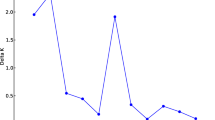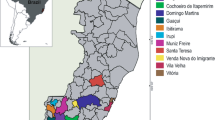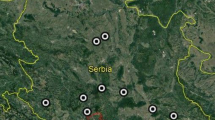Abstract
Eighty-seven Phaseolus vulgaris landraces, still cultivated in Calabria (Italy), were investigated in order to study the patterns of common bean genetic diversity in this region, to better understand the evolutionary development of beans in Europe and to properly manage these genetic resources. Four American accessions and five Italian varieties were also included. Different markers, such as 12 microsatellites, seed traits, phaseolins and 100-seed weight were combined with different statistical approaches. For each microsatellite, expected (H e ) and observed (H o ) heterozygosities, polymorphism information content (PIC), probability of identity (PI) and homozygosity were calculated. Furthermore, in Calabrian group of bean landraces, total (N a ) and private (N pa ) number of alleles, observed (H o ), expected heterozygosities (H e ) and allelic richness (AR) were calculated. Genetic distances among landraces were estimated using Nei’s coefficient and a cluster analysis using the UPGMA algorithm was performed. The results clearly indicated that: (1) Calabrian germplasm showed a high level of diversity (H e = 0.595); (2) Mesoamerican and Andean gene pools were clearly distinguished in Calabrian germplasm, with the Andean gene pool predominating (83 %); (3) Calabrian landraces were largely hybridized within and between the gene pools. A model-based approach, using the STRUCTURE software, was adopted. Six groups, including 4 of Andean origin and one of Mesoamerican origin were identified. Even more interesting, a small group (8 %) showed a distinct genetic structure, in which interspecific hybridizations with runner bean (Phaseolus coccineus L.) could have occurred. Nevertheless, a relatively high proportion of Calabrian bean landraces (12.6 %) was derived from intra and interspecific hybridizations.




Similar content being viewed by others
References
Acampora A, Ciaffi M, De Pace C, Paolacci AR, Tanzarella OA (2007) Pattern of variation for seed size traits and molecular markers in Italian germplasm of Phaseolus coccineus L. Euphytica 157:69–82
Angioi SA, Rau D, Rodriguez M, Logozzo G, Desiderio F, Papa R, Attene G (2009) Nuclear and chloroplast microsatellite diversity in Phaseolus vulgaris L. from Sardinia (Italy). Mol Breed 23:413–429
Angioi SA, Rau D, Attene G, Nanni L, Bellucci E, Logozzo G, Negri V, Spagnoletti Zeuli PL, Papa R (2010) Beans in Europe: origin and structure of the European landraces of Phaseolus vulgaris L. Theor Appl Genet 121:829–843
Beaver JS, Osorno JM (2009) Achievements and limitations of contemporary common bean breeding using conventional and molecular approaches. Euphytica 168(2):145–175
Beebe S, Skroch P, Tohme J, Duque MC, Pedraza F, Nienhuis J (2000) Structure of genetic diversity among common bean landraces of Middle American origin based on correspondence analysis of RAPD. Crop Sci 40:264–273
Beebe S, Renjifo J, Gaitán-Solís E, Duque MC, Tohme J (2001) Diversity and origin of andean landraces of common bean. Crop Sci 41:854–862
Blair MW, Pedraza F, Buendia HF, Gaitán-Solís E, Beebe SE, Gepts P, Tohme J (2003) Development of a genome-wide anchored microsatellite map for common bean (Phaseolus vulgaris L.). Theor Appl Genet 107:1362–1374
Blair MW, Giraldo MC, Buendía HF, Tovar E, Duque MC, Beebe SE (2006) Microsatellite marker diversity in common bean (Phaseolus vulgaris L.). Theor Appl Genet 113:100–109
Blair MW, Diaz JM, Hidalgo R, Diaz LM, Duque MC (2007) Microsatellite characterization of andean races of common bean (Phaseolus vulgaris L.). Theor Appl Genet 116:29–43
Blair MW, Díaz LM, Buendía HF, Duque MC (2009) Genetic diversity, seed size associations and population structure of a core collection of common beans (Phaseolus vulgaris L.). Theor Appl Genet 119:955–972
Broughton WJ, Hernandez G, Blair M, Beebe S, Gepts P, Vanderleyden J (2003) Beans (Phaseolus spp.)—model food legumes. Plant Soil 252:55–128
Burle ML, Fonseca JR, Kami JA, Gepts P (2010) Microsatellite diversity and genetic structure among common bean (Phaseolus vulgaris L.) landraces in Brazil, a secondary center of diversity. Theor Appl Genet 121:801–813
CIAT (centro international de agricoltura tropical) (1986) The cultivated species of Phaseolus. Scientific content: Hidalgo R, Song L, Gepts P. Production: Fernando Fernandez O, Cali, Colombia, series: 04EB09.02
Escribano MR, Santalla M, Casquero PA, Ron AM, De Ron AM (1998) Patterns of genetic diversity in landraces of common bean (Phaseolus vulgaris L.) from Galicia. Plant Breed 117:49–56
Evanno G, Regnaut S, Goudet J (2005) Detecting the number of clusters of individuals using the software STRUCTURE: a simulation study. Mol Ecol 14:2611–2620
FAOSTAT (2009) ProdSTAT: crops. FAO statistical databases (FAOSTAT), food and agriculture organization of the United Nations (FAO), http://faostat.fao.org
Freyre R, Rios R, Guzman L, Debouck D, Gepts P (1996) Ecogeographic distribution of Phaseolus spp. (Fabaceae) in Bolivia. Econ Bot 50:195–215
Freyre R, Skroch P, Geffroy V, Adam-Blondon AF, Shirmohamadali A, Johnson W, Llaca V, Nodari R, Pereira P, Tsai SM, Tohme J, Dron M, Nienhuis J, Vallejos C, Gepts P (1998) Towards an integrated linkage map of common bean. 4. development of a core map and alignment of RFLP maps. Theor Appl Genet 97:847–856
Gaitán-Solís E, Duque MC, Edwards KJ, Tohme J (2002) Microsatellite repeats in common bean (Phaseolus vulgaris): isolation, characterization, and cross-species amplification in Phaseolus ssp. Crop Sci 42:2128–2136
Gepts P (1988) Phaseolin as an evolutionary marker. Resources of Phaseolus beans. Kluwer, Dordrecht, In, pp 215–241
Gepts P, Bliss FA (1986) Phaseolin variability among wild and cultivated common beans (Phaseolus vulgaris) from Colombia. Econ Bot 40:469–478
Gepts P, Debouck DG (1991) Origin, domestication and evolution of the common bean, Phaseolus vulgaris. In: Voysest O, Van Schoonhoven A (eds) Common Beans: research for crop improvement, 2nd edn. CAB, Oxford, pp 7–53
Gepts P, Osborn TC, Rashka K, Bliss FA (1986) Phaseolin-protein variability in wild forms and landraces of the common bean (Phaseolus vulgaris): evidence for multiple centers of domestication. Econ Bot 40:451–468
Goudet J (2002) FSTAT: a program to estimate and test gene diversities and fixation indices. Version 2.9.3.2
Guerra-Sanz JM (2004) New SSR markers of Phaseolus vulgaris from sequence databases. Plant Breed 123:87–89
Ibarra-Perez F, Ehadaie B, Waines G (1997) Estimation of outcrossing rate in common bean. Crop Sci 37:60–65
IBPGR(IPGRI) (1982) Phaseolus vulgaris descriptors. Rome, p 32
Jarvis D, Brown AHD, Cuong PH, Panduro CL, Moreno LL, Gyawali S, Tanto T, Sawadogo M, Mar I, Sadiki M, Hue NTN, Reyes AL, Balma D, Bajracharya J, Castillo F, Rijal D, Belqadi L, Rana R, Seddik S, Ouedraogo J, Zangre R, Rhrib K, Chavez JL, Schoen D, Sthapit B, De Santis P, Fadda C, Hodgking T (2008) A global perspective of the richness and evenness of traditional crop-variety diversity maintained by farming communities. PNAS 105:5326–5331
Koenig R, Gepts P (1989) Allozyme diversity in wild Phaseolus vulgaris: further evidence for two major centers of diversity. Theor Appl Genet 78:809–817
Kwak M, Gepts P (2009) Structure of genetic diversity in the two major gene pools of common bean (Phaseolus vulgaris L., Fabaceae). Theor Appl Genet 118:979–992
Limongelli G, Laghetti G, Perrino P, Piergiovanni AR (1996) Variation of seed storage protein in landraces of common bean (Phaseolus vulgaris L.) from Basilicata, southern Italy. Euphytica 92:393–399
Liu K, Muse SV (2005) Powermarker: an integrated analysis environment for genetic marker analysis. Bioinformatics 21:2128–2129
Lodhi MA, Ye GN, Weeden NF, Reisch BI (1994) A simple and efficient method for DNA extraction from grapevine cultivars and Vitis species. Plant Mol Biol Rep 12:6–13
Logozzo G, Donnoli R, Macaluso L, Papa R, Knüpffer H, Spagnoletti Zeuli P (2007) Analysis of the contribution of Mesoamerican and andean gene pools to European common bean (Phaseolus vulgaris L.) germplasm and strategies to establish a core collection. Genet Resour Crop Evol 54:1763–1779
Ma Y, Bliss F (1978) Seed proteins of common bean. Crop Sci 18:431–437
Masi P, Spagnoletti Zeuli PL, Donini P (2003) Development and analysis of multiplex microsatellite markers sets in common bean (Phaseolus vulgaris L.). Mol Breed 11:303–313
Nei M (1973) The theory and estimation of genetic distance p45–54 in genetic structure of populations, edited by Morton NE. University Press of Hawaii, Honolulu
Nei M (1987) Molecular evolutionary genetics. Columbia University Press, New York
Paetkau D, Calvert W, Stirling I, Stroberk C (1995) Microsatellite analysis of population structure in Canadian polar bears. Mol Ecol 4:347–354
Page RDM (1996) Treeview: an application to display phylogenetic trees on personal computers. Comput Appl Biosci 12:357–358
Pallottini L, Garcia E, Kami J, Barcaccia G, Gepts P (2004) The genetic anatomy of a patented yellow bean. Crop Sci 44:968–977
Papa R, Gepts P (2003) Asymmetry of gene flow and differential geographical structure of molecular diversity in wild and domesticated common bean (Phaseolus vulgaris L.) from Mesoamerica. Theor Appl Genet 106:239–250
Papa R, Nanni L, Sicard D, Rau D, Attene G (2006) The evolution of genetic diversity in Phaseolus vulgaris L. In: Motley TJ, Zerega N, Cross H (eds) Darwin’s harvest: new approaches to the origins, evolution, and conservation of crop. Columbia University Press, New York, pp 121–142
Peakall R, Smouse PE (2006) GenAlEx6: genetic analysis in excel. population genetic software for teaching and research. Mol Ecol Notes 6:288–295
Piergiovanni AR, Lioi L (2010) Italian common bean landraces: history, genetic diversity and seed quality. Diversity 2:837–862
Piergiovanni AR, Cerbino D, Brandi M (2000a) The common bean populations from Basilicata (southern Italy). an evaluation of their variation. Genet Resour Crop Evol 47:489–495
Piergiovanni AR, Taranto G, Pignone D (2000b) Diversity among common bean populations from the Abruzzo region (central Italy): a preliminary inquiry. Genet Resour Crop Evol 47:467–470
Piergiovanni AR, Taranto G, Losavio FP, Pignone D (2006) Common bean (Phaseolus vulgaris L.) landraces from Abruzzo and Lazio regions (Central Italy). Genet Resour Crop Evol 53:313–322
Pritchard JK, Wen W (2003) Documentation for STRUCTURE Software Version 2. http://pritch.bsd.uchicago.edu
Santalla M, Monteagudo AB, Gonzalez AM, Lema M, De la Fuente M, De Ron AM (2004) Agronomic potential value of great northern recombinant lines and breeding implications in common bean. Annu Rep Bean Improv Coop 47:147–148
Sicard D, Nanni L, Porfiri O, Bulfon D, Papa R (2005) Genetic diversity of Phaseolus vulgaris L and P. coccineus L. landraces in central Italy. Plant Breed 124:464–472
Singh SP, Gepts P, Debouck DG (1991a) Races of common bean (Phaseolus vulgaris L., Fabaceae). Econ Bot 45:379–396
Singh SP, Gutierrez JA, Molina A, Urrea C, Gepts P (1991b) Genetic diversity in cultivated common bean: II. marker-based analysis of morphological and agronomic traits. Crop Sci 31:23–29
Singh SP, Nodari R, Gepts P (1991c) Genetic diversity in cultivated common bean. I Allozymes Crop Sci 31:19–23
Spataro G, Tiranti B, Arcaleni P, Bellucci E, Attene G, Papa R, Spagnoletti Zeuli P, Negri V (2011) Genetic diversity and structure of a worldwide collection of Phaseolus coccineus L. Theor Appl Genet 122:1281–1291
Tohme J, Gonzalez DO, Beebe S, Duque MC (1996) AFLP analysis of gene pools of a wild bean core collection. Crop Sci 36:1375–1384
Wagner HW, Sefc KM (1999) IDENTITY 1.0. Centre for Applied Genetics, University of Agricultural Sciences, Vienna
Weber JL (1990) Informativeness of human (dC-dA)n-(dGdT)n polymorphisms. Genomics 7:524–530
Wells WC, Isom WH, Waines JG (1988) Outcrossing rates of six common bean lines. Crop Sci 28:177–178
Yu K, Park J, Poysa V, Gepts P (2000) Integration of simple sequence repeat (SSR) markers into a molecular linkage map of common bean (Phaseolus vulgaris L.). Am Genet Assoc 91:429–434
Zhang X, Blair MW, Wang S (2008) Genetic diversity of Chinese common bean (Phaseolus vulgaris L.) landraces assessed with simple sequence repeat markers. Theor Appl Genet 117:629–640
Acknowledgments
This study was supported by a grant from “Agenzia Regionale Sperimentazione Servizi in Agricoltura (ARSSA–Calabria)” in the frame of the projects ‘‘Programma Interregionale–P.O. Proteine Vegetali’’. The Authors would like to thank the referents from ARSSA farm of Rogliano (CS), M. Turco, M. Convertino, M. Bruno and F. Filella, for their attempts against the loss of biodiversity and in obtaining the seed collection.
Author information
Authors and Affiliations
Corresponding author
Electronic supplementary material
Below is the link to the electronic supplementary material.
Rights and permissions
About this article
Cite this article
Mercati, F., Leone, M., Lupini, A. et al. Genetic diversity and population structure of a common bean (Phaseolus vulgaris L.) collection from Calabria (Italy). Genet Resour Crop Evol 60, 839–852 (2013). https://doi.org/10.1007/s10722-012-9879-6
Received:
Accepted:
Published:
Issue Date:
DOI: https://doi.org/10.1007/s10722-012-9879-6




